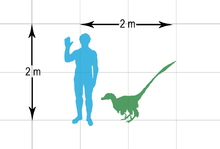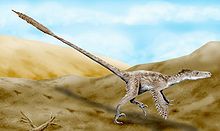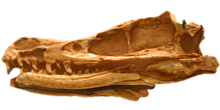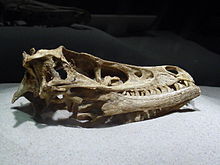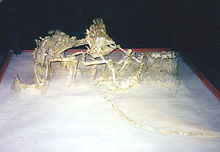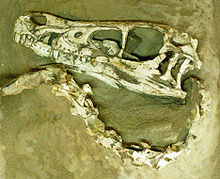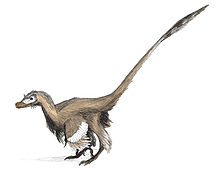- Velociraptor
-
This article is about the dinosaur. For the Kasabian album, see Velociraptor!. For other uses, see Raptor (disambiguation).
Velociraptor
Temporal range: Late Cretaceous, 75–71 Ma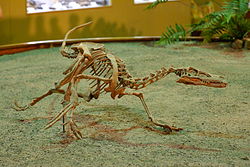
Mounted cast at Wyoming Dinosaur Center Scientific classification 
Kingdom: Animalia Class: Reptilia Superorder: Dinosauria Order: Saurischia Suborder: Theropoda Family: †Dromaeosauridae Node: †Eudromaeosauria Subfamily: †Velociraptorinae Genus: †Velociraptor
Osborn, 1924Type species Velociraptor mongoliensis
Osborn, 1924Species - †V. mongoliensis Osborn, 1924
- †V. osmolskae Godefroit et al., 2008
Velociraptor (
 /vɨˈlɒsɨræptər/; meaning 'swift seizer')[1] is a genus of dromaeosaurid theropod dinosaur that existed approximately 75 to 71 million years ago during the later part of the Cretaceous Period.[2] Two species are currently recognized, although others have been assigned in the past. The type species is V. mongoliensis; fossils of this species have been discovered in Mongolia. A second species, V. osmolskae, was named in 2008 for skull material from Inner Mongolia, China.
/vɨˈlɒsɨræptər/; meaning 'swift seizer')[1] is a genus of dromaeosaurid theropod dinosaur that existed approximately 75 to 71 million years ago during the later part of the Cretaceous Period.[2] Two species are currently recognized, although others have been assigned in the past. The type species is V. mongoliensis; fossils of this species have been discovered in Mongolia. A second species, V. osmolskae, was named in 2008 for skull material from Inner Mongolia, China.Smaller than other dromaeosaurids like Deinonychus and Achillobator, Velociraptor nevertheless shared many of the same anatomical features. It was a bipedal, feathered carnivore with a long, stiffened tail and an enlarged sickle-shaped claw on each hindfoot, which is thought to have been used to kill its prey. Velociraptor can be distinguished from other dromaeosaurids by its long and low skull, with an upturned snout.
Velociraptor (commonly shortened to 'raptor') is one of the dinosaur genera most familiar to the general public due to its prominent role in the Jurassic Park motion picture series. In the films it was shown with anatomical inaccuracies, including being much larger than it was in reality and without feathers. It is also well known to paleontologists, with over a dozen described fossil skeletons—the most of any dromaeosaurid. One particularly famous specimen preserves a Velociraptor locked in combat with a Protoceratops.
Contents
Description
Velociraptor was a mid-sized dromaeosaurid, with adults measuring up to 2.07 m (6.8 ft) long, 0.5 m (1.6 ft) high at the hip, and weighing up to 15 kg (33 lb).[3] The skull, which grew up to 25 cm (9.8 in) long, was uniquely up-curved, concave on the upper surface and convex on the lower. The jaws were lined with 26–28 widely spaced teeth on each side, each more strongly serrated on the back edge than the front—possibly an adaptation that improved its ability to catch and hold fast-moving prey.[1][4]
Velociraptor, like other dromaeosaurids, had a large manus ('hand') with three strongly curved claws, which were similar in construction and flexibility to the wing bones of modern birds. The second digit was the longest of the three digits present, while the first was shortest. The structure of the carpal (wrist) bones prevented pronation of the wrist and forced the 'hands' to be held with the palmar surface facing inwards (medially), not downwards.[5] The first digit of the foot, as in other theropods, was a small dewclaw. However, whereas most theropods had feet with three digits contacting the ground, dromaeosaurids like Velociraptor walked on only their third and fourth digits. The second digit, for which Velociraptor is most famous, was highly modified and held retracted off of the ground. It bore a relatively large, sickle-shaped claw, typical of dromaeosaurid and troodontid dinosaurs. This enlarged claw, which could be over 6.5 cm (2.6 in) long around its outer edge, was most likely a predatory device used to tear into prey, possibly delivering a fatal blow.[6][7]
Long bony projections (prezygapophyses) on the upper surfaces of the vertebrae, as well as ossified tendons underneath, stiffened the tail of Velociraptor. The prezygapophyses began on the tenth tail (caudal) vertebra and extended forward to brace four to ten additional vertebrae, depending on position in the tail. The stiffening forced the entire tail to act as a single rod-like unit, preventing vertical motion between vertebrae. However, at least one specimen preserves a series of intact tail vertebrae curved sideways into an S-shape, suggesting that there was considerably more horizontal flexibility. These adaptations of the tail probably provided balance and stability while turning, especially at high speeds.[6][7]
In 2007, paleontologists reported the discovery of quill knobs on a well-preserved Velociraptor mongoliensis forearm from Mongolia, confirming the presence of feathers in this species.[8]
History
During an American Museum of Natural History expedition to the Outer Mongolian Gobi Desert, on 11 August 1923 Peter Kaisen recovered the first Velociraptor fossil known to science: a crushed but complete skull, associated with one of the raptorial second toe claws (AMNH 6515).[1] In 1924, museum president Henry Fairfield Osborn designated the skull and claw (which he assumed to come from the hand) as the type specimen of his new genus, Velociraptor. This name is derived from the Latin words velox ('swift') and raptor ('robber' or 'plunderer') and refers to the animal's cursorial nature and carnivorous diet. Osborn named the type species V. mongoliensis after its country of origin.[1] Earlier that year, Osborn had mentioned the animal in a popular press article, under the name "Ovoraptor djadochtari" (not to be confused with the similarly named Oviraptor).[9] However, because the name "Ovoraptor" was not published in a scientific journal or accompanied by a formal description, it is considered a nomen nudum ('naked name'), and the name Velociraptor retains priority.
While North American teams were shut out of communist Mongolia during the Cold War, expeditions by Soviet and Polish scientists, in collaboration with Mongolian colleagues, recovered several more specimens of Velociraptor. The most famous is part of the legendary "Fighting Dinosaurs" specimen (GIN 100/25), discovered by a Polish-Mongolian team in 1971. This fossil preserves a single Velociraptor in the midst of battle against a lone Protoceratops.[6][10][11] This specimen is considered a national treasure of Mongolia, although in 2000 it was loaned to the American Museum of Natural History in New York City for a temporary exhibition.[12]
Between 1988 and 1990, a joint Chinese-Canadian team discovered Velociraptor remains in northern China.[13] American scientists returned to Mongolia in 1990, and a joint Mongolian-American expedition to the Gobi, led by the American Museum of Natural History and the Mongolian Academy of Sciences, turned up several well-preserved skeletons.[7][14] One such specimen, IGM 100/980, was nicknamed "Ichabodcraniosaurus" by Norell's team because the fairly complete specimen was found without its skull (an allusion to the Washington Irving character Ichabod Crane).[15] This specimen may belong to Velociraptor mongoliensis, but Norell and Makovicky concluded that it was not complete enough to say for sure, and it awaits a formal description.[7]
Maxillae and a lacrimal (the main tooth-bearing bones of the upper jaw, and the bone that forms the anterior margin of the eye socket, respectively) recovered in 1999 by the Sino-Belgian Dinosaur Expeditions were found to pertain to Velociraptor, but not to the type species V. mongoliensis. Pascal Godefroit and colleagues named these bones V. osmolskae (for Polish paleontologist Halszka Osmólska) in 2008.[2]
Provenance
All known specimens of Velociraptor mongoliensis were discovered in the Djadochta Formation (also spelled Djadokhta), in the Mongolian province of Ömnögovi. Species of Velociraptor, have also been reported from the slightly younger Barun Goyot Formation of Mongolia,[16] though these are indeterminate and may belong to a related genus instead.[17] These geologic formations are estimated to date back to the Campanian stage (between 83 and 70 million years ago[18]) of the Late Cretaceous Epoch.[19]
V. mongoliensis has been found at many of the most famous and prolific Djadochta localities. The type specimen was discovered at the Flaming Cliffs site (also known as Bayn Dzak and Shabarakh Usu),[1] while the "Fighting Dinosaurs" were found at the Tugrig locality (also known as Tugrugeen Shireh).[11] The well-known Barun Goyot localities of Khulsan and Khermeen Tsav have also produced remains which may belong to Velociraptor or a related genus.[20] Teeth and partial remains attributed to juvenile V. mongoliensis have also been reported from the Bayan Mandahu Formation, a prolific site in Inner Mongolia, China that is contemporaneous with the Djadochta Formation.[13] However, these fossils had not been prepared or studied as of 2008.[2] A partial adult skull from the Bayan Mandahu Formation has been assigned to a distinct species, Velociraptor osmolskae.[2]
Paleoecology
All of the fossil sites that have yielded Velociraptor remains preserve an arid environment with fields of sand dunes and only intermittent streams, although the younger Barun Goyot environment seems to have been slightly wetter than the older Djadochta.[19] The posture of some complete fossils, as well as the mode of preservation most show within structureless sandstone deposits, may show that a number of specimens were buried alive during sandstorm events common to the three environments.[2]
Many of the same genera were present across these formations, though they varied at the species level. For example, the Djadochta was inhabited by Velociraptor mongoliensis, Protoceratops andrewsi, and Pinacosaurus grangeri, while the Bayan Mandahu was home to Velociraptor osmolskae, Protoceratops hellenikorhinus, and Pinacosaurus mephistocephalus. These differences in species composition may be due a natural barrier separating the two formations, which are relatively close to each other geographically.[2] However, given the lack of any known barrier which would cause the specific faunal compositions found in these areas, it is more likely that those differences indicate a slight time difference.[17]
Other dinosaurs known from the same locality as V. mongoliensis include the troodontid Saurornithoides mongoliensis, the oviraptorid Oviraptor philoceratops, and the dromaeosaurid Mahakala omnogovae. V. osmolskae lived alongside the ceratopsian species Magnirostris dodsoni, as well as the oviraptorid Machairasaurus leptonychus and the dromaeosaurid Linheraptor exquisitus.[17]
Classification
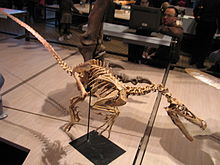 Mounted skeleton cast, Museum voor Natuurwetenschappen, Brussels
Mounted skeleton cast, Museum voor Natuurwetenschappen, Brussels
Velociraptor is a member of the subfamily Velociraptorinae, a derived sub-group of the larger family Dromaeosauridae. In phylogenetic taxonomy, Velociraptorinae is usually defined as "all dromaeosaurs more closely related to Velociraptor than to Dromaeosaurus." Dromaeosaurid classification is highly variable. Originally, the subfamily Velociraptorinae was erected solely to contain Velociraptor.[6] Other analyses have included other genera, usually Deinonychus and Saurornitholestes.[21] A recent cladistic analysis indicated a monophyletic Velociraptorinae containing Velociraptor, Deinonychus, Tsaagan, and a closely related (but uncertainly positioned) Saurornitholestes.[22]
In the past, other dromaeosaurid species, including Deinonychus antirrhopus and Saurornitholestes langstoni, have sometimes been classified in the genus Velociraptor. Since Velociraptor was the first to be named, these species were renamed Velociraptor antirrhopus and V. langstoni.[3] However, the only currently recognized species of Velociraptor are V. mongoliensis[4][5][23] and V. osmolskae.[2]
When first described in 1924, Velociraptor was placed in the family Megalosauridae, as was the case with most carnivorous dinosaurs at the time (Megalosauridae, like Megalosaurus, functioned as a sort of 'wastebin' taxon, where many unrelated species were grouped together).[1] As dinosaur discoveries multiplied, Velociraptor was later recognized as a dromaeosaurid. All dromaeosaurids have also been referred to the family Archaeopterygidae by at least one author (which would, in effect, make Velociraptor a flightless bird).[5]
Paleobiology
Predatory behavior
The "Fighting Dinosaurs" specimen, found in 1971, preserves a Velociraptor mongoliensis and Protoceratops andrewsi in combat and provides direct evidence of predatory behavior. When originally reported, it was hypothesized that the two animals drowned.[11] However, as the animals were preserved in ancient sand dune deposits, it is now thought that the animals were buried in sand, either from a collapsing dune or in a sandstorm. Burial must have been extremely fast, judging from the lifelike poses in which the animals were preserved. Both forelimbs and one hindlimb of the Protoceratops are missing, which has been seen as evidence of scavenging by other animals.[24] Comparisons between the scleral rings of Velociraptor, Protoceratops, and modern birds and reptiles indicates that Velociraptor may have been nocturnal, while Protoceratops may have been cathemeral, active throughout the day during short intervals, suggesting that the fight may have occurred at twilight or during low-light conditions.[25]
The distinctive claw, on the second digit of dromaeosaurids, has traditionally been depicted as a slashing weapon; its assumed use being to cut and disembowel prey.[26] In the "Fighting Dinosaurs" specimen, the Velociraptor lies underneath, with one of its sickle claws apparently embedded in the throat of its prey, while the beak of Protoceratops is clamped down upon the right forelimb of its attacker. This suggests Velociraptor may have used its sickle claw to pierce vital organs of the throat, such as the jugular vein, carotid artery, or trachea (windpipe), rather than slashing the abdomen. The inside edge of the claw was rounded and not unusually sharp, which may have precluded any sort of cutting or slashing action, although only the bony core of the claw is known. The thick abdominal wall of skin and muscle of large prey species would have been difficult to slash without a specialized cutting surface.[24] The slashing hypothesis was tested during a 2005 BBC documentary, The Truth About Killer Dinosaurs. The producers of the program created an artificial Velociraptor leg with a sickle claw and used a pork belly to simulate the dinosaur's prey. Though the sickle claw did penetrate the abdominal wall, it was unable to tear it open, indicating that the claw was not used to disembowel prey. However, this experiment has not been published or repeated by other scientists, so its results cannot be confirmed.
Remains of Deinonychus, a closely related dromaeosaurid, have commonly been found in aggregations of several individuals. Deinonychus has also been found in association with a large herbivore, Tenontosaurus, which has been seen as evidence of cooperative hunting.[27][28] The only solid evidence for social behavior among dromaeosaurids comes from a Chinese trackway of fossil footprints, which shows six individuals of a large species moving as a group, though no evidence of cooperative hunting was found.[29] Although many isolated fossils of Velociraptor have been found in Mongolia, none were closely associated with any other individuals.[23] Therefore, while Velociraptor is commonly depicted as a pack hunter, as in Jurassic Park, there is only limited fossil evidence to support this theory for dromaeosaurids in general, and none specific to Velociraptor itself. The pack hunting theory was based on a discovery of several specimens of Deinonychus found around the remains of a Tenontosaurus. No other group of dromaeosaurids has been found in close association.[30]
Scavenging behavior
In 2010, Hone and colleagues published a paper on their 2008 discovery of shed teeth of what they believed to be a Velociraptor near a tooth-marked jaw bone of what they believed to be a Protoceratops in the Bayan Mandahu Formation.[31] The authors concluded that the find represented "late-stage carcass consumption by Velociraptor" as the predator would have eaten other parts of a freshly killed Protoceratops before biting in the jaw area.[31][32] The evidence was seen as supporting the inference from the "Fighting Dinosaurs" fossil that Protoceratops was part of the diet of Velociraptor.[31]
Metabolism
Velociraptor was probably warm-blooded to some degree, as it required a significant amount of energy to hunt. Modern animals that possess feathery or furry coats, like Velociraptor did, tend to be warm-blooded, since these coverings function as insulation. However, bone growth rates in dromaeosaurids and some early birds suggest a more moderate metabolism, compared with most modern warm-blooded mammals and birds. The kiwi is similar to dromaeosaurids in anatomy, feather type, bone structure and even the narrow anatomy of the nasal passages (usually a key indicator of metabolism). The kiwi is a highly active, if specialized, flightless bird, with a stable body temperature and a fairly low resting metabolic rate, making it a good model for the metabolism of primitive birds and dromaeosaurids.[5]
Feathers
Fossils of dromaeosaurids more primitive than Velociraptor are known to have had feathers covering their bodies, and fully developed, feathered wings.[33] The fact that the ancestors of Velociraptor were feathered and possibly capable of flight long suggested to paleontologists that Velociraptor bore feathers as well, since even flightless birds today retain most of their feathers.
In September 2007, researchers found quill knobs on the forearm of a Velociraptor found in Mongolia.[8] These bumps on bird wing bones show where feathers anchor, and their presence on Velociraptor indicate it too had feathers. According to paleontologist Alan Turner,
“ A lack of quill knobs does not necessarily mean that a dinosaur did not have feathers. Finding quill knobs on Velociraptor, though, means that it definitely had feathers. This is something we'd long suspected, but no one had been able to prove.[34] ” Co-author Mark Norell, Curator-in-Charge of fossil reptiles, amphibians and birds at the American Museum of Natural History, also weighed in on the discovery, saying:
“ The more that we learn about these animals the more we find that there is basically no difference between birds and their closely related dinosaur ancestors like velociraptor. Both have wishbones, brooded their nests, possess hollow bones, and were covered in feathers. If animals like velociraptor were alive today our first impression would be that they were just very unusual looking birds.[34] ” According to Turner and co-authors Norell and Peter Makovicky, quill knobs are not found in all prehistoric birds, and their absence does not mean that an animal was not feathered – flamingos, for example, have no quill knobs. However, their presence confirms that Velociraptor bore modern-style wing feathers, with a rachis and vane formed by barbs. The forearm specimen on which the quill knobs were found (specimen number IGM 100/981) represents an animal 1.5 meters in length (5 ft) and 15 kilograms (33 lbs) in weight. Based on the spacing of the six preserved knobs in this specimen, the authors suggested that Velociraptor bore 14 secondaries (wing feathers stemming from the forearm), compared with 12 or more in Archaeopteryx, 18 in Microraptor, and 10 in Rahonavis. This type of variation in the number of wing feathers between closely related species, the authors asserted, is to be expected, given similar variation among modern birds.[8]
Turner and colleagues interpreted the presence of feathers on Velociraptor as evidence against the idea that the larger, flightless maniraptorans lost their feathers secondarily due to larger body size. Furthermore, they noted that quill knobs are almost never found in flightless bird species today, and that their presence in Velociraptor (presumed to have been flightless due to its relatively large size and short forelimbs) is evidence that the ancestors of dromaeosaurids could fly, making Velociraptor and other large members of this family secondarily flightless, though it is possible the large wing feathers inferred in the ancestors of Velociraptor had a purpose other than flight. The feathers of the flightless Velociraptor may have been used for display, for covering their nests while brooding, or for added speed and thrust when running up inclined slopes.[8]
Pathology
Main article: PaleopathologyOne Velociratoptor mongoliensis skull bears two parallel rows of small punctures that match the spacing and size of Velociraptor teeth. Scientists believe that the wound was likely inflicted by another Velociraptor during a fight. Further, because the fossil bone shows no sign of healing near the bite wounds, the injury probably killed it.[35]
In popular culture
Velociraptor are well known for their role as vicious and cunning killers in the 1990 novel Jurassic Park by Michael Crichton and its 1993 film adaptation, directed by Steven Spielberg, in which they served as the main antagonists. The "raptors" portrayed in Jurassic Park were modeled after a larger relative, Deinonychus, which Gregory Paul at the time called Velociraptor antirrhopus.[3] The paleontologists in the film and the novel excavate a so-called Velociraptor skeleton in Montana, far from the central Asian range of Velociraptor but well within the range of Deinonychus. A character in Crichton's novel also states that "…Deinonychus is now considered one of the velociraptors", indicating that Crichton used Paul's taxonomy, though the "raptors" in the novel are referred to as V. mongoliensis.[36]
The filmmakers also had the size of the film's Velociraptor increased for dramatic reasons, and changed the shape of the snout.[37][38] Additionally, the forelimbs of the film animals differed in structure and posture from those of real dromaeosaurids and their tails were too short and flexible, anatomical errors which directly contradict fossil evidence. Another noticeable difference is the lack of feathers for the novel and film version of Velociraptor. In real life, Velociraptor, like many other maniraptoran theropods, was covered in feathers. Jurassic Park and The Lost World: Jurassic Park, however, were released before this was known. In Jurassic Park III, the Velociraptor are depicted with quill-like structures along the back of the head and neck, although these do not resemble the down-like feathers known from real-life dromaeosaurids, and the quill knobs on some Velociraptor specimens show that they had fully developed feathers akin to those of modern birds.[8] Also in Jurassic Park III, Dr. Alan Grant, played by Sam Neill, states that Velociraptor were smarter than dolphins, whales and some primates. Given only fossil evidence, this is impossible to ascertain and is purely conjecture.
Due to the success of many Jurassic Park-related products, Velociraptor has become a ubiquitous representation of dinosaurs in popular culture. It has been featured in numerous toy lines, animated films, video games and television series for children, along with several television documentaries. In 1995, the city of Toronto was awarded a National Basketball Association expansion team, which was named the Toronto Raptors.
References
- ^ a b c d e f Osborn, Henry F. (1924a). "Three new Theropoda, Protoceratops zone, central Mongolia". American Museum Novitates 144: 1–12. http://hdl.handle.net/2246/3223.
- ^ a b c d e f g Godefroit, Pascal; Currie, Philip J.; Li, Hong; Shang, Chang Yong; Dong, Zhi-ming (2008). "A new species of Velociraptor (Dinosauria: Dromaeosauridae) from the Upper Cretaceous of northern China". Journal of Vertebrate Paleontology 28 (2): 432–438. doi:10.1671/0272-4634(2008)28[432:ANSOVD]2.0.CO;2.
- ^ a b c Paul, Gregory S. (1988). Predatory Dinosaurs of the World. New York: Simon and Schuster. pp. 464pp. ISBN 978-0-6716-1946-6.
- ^ a b Barsbold, Rinchen; Osmólska, Halszka (1999). "The skull of Velociraptor (Theropoda) from the Late Cretaceous of Mongolia". Acta Palaeontologica Polonica 44 (2): 189–219. http://app.pan.pl/article/item/app44-189.html.
- ^ a b c d Paul, Gregory S. (2002). Dinosaurs of the Air: The Evolution and Loss of Flight in Dinosaurs and Birds. Baltimore: Johns Hopkins University Press. ISBN 978-0801867637.
- ^ a b c d Barsbold, Rinchen (1983). "Carnivorous dinosaurs from the Cretaceous of Mongolia". Transactions of the Joint Soviet-Mongolian Paleontological Expedition 19: 5–119.
- ^ a b c d Norell, Mark A.; Makovicky, Peter J. (1999). "Important features of the dromaeosaurid skeleton II: information from newly collected specimens of Velociraptor mongoliensis". American Museum Novitates 3282: 1–45. http://hdl.handle.net/2246/3025.
- ^ a b c d e Turner, A.H.; Makovicky, P.J.; Norell, M.A. (2007). "Feather quill knobs in the dinosaur Velociraptor". Science 317 (5845): 1721. doi:10.1126/science.1145076. PMID 17885130.
- ^ Osborn, Henry F. (1924b). "The discovery of an unknown continent". Natural History 24: 133–149.
- ^ Kielan-Jaworowska, Zofia; Barsbold, Rinchen (1972). "Narrative of the Polish-Mongolian Paleontological Expeditions". Paleontologica Polonica 27: 5–13.
- ^ a b c Barsbold, Rinchen (1974). "Saurornithoididae, a new family of theropod dinosaurs from Central Asia and North America". Paleontologica Polonica 30: 5–22.
- ^ American Museum of Natural History (c.2000). "Fighting Dinosaurs: New Discoveries from Mongolia: Exhibition Highlights". http://www.amnh.org/exhibitions/fightingdinos/ex-fd.php. Retrieved 2010-08-20.
- ^ a b Jerzykiewicz, Tomasz; Currie, Philip J.; Eberth, David A.; Johnston, P.A.; Koster, E.H.; Zheng, J.-J. (1993). "Djadokhta Formation correlative strata in Chinese Inner Mongolia: an overview of the stratigraphy, sedimentary geology, and paleontology and comparisons with the type locality in the pre-Altai Gobi". Canadian Journal of Earth Sciences 30 (10): 2180–2195. doi:10.1139/e93-190. http://rparticle.web-p.cisti.nrc.ca/rparticle/AbstractTemplateServlet?calyLang=eng&journal=cjes&volume=30&year=0&issue=10&msno=e93-190.
- ^ Norell, Mark A.; Makovicky, Peter J. (1997). "Important features of the dromaeosaur skeleton: information from a new specimen". American Museum Novitates 3215: 1–28. http://hdl.handle.net/2246/3557.
- ^ Novacek, Michael J. (1996). Dinosaurs of the Flaming Cliffs. New York: Anchor Books. ISBN 0385477740.
- ^ Weishampel, David B.; Barrett, Paul M.; Coria, Rodolfo A.; Le Loueff, Jean; Xu, Xing; Zhao, Xijin; Sahni, Ashok; Gomani, Emily M.P.; Noto, Christopher N. (2004). "Dinosaur distribution". In Weishampel, David B., Dodson, Peter & Osmólska, Halszka (eds.).. The Dinosauria (Second ed.). Berkeley: University of California Press. pp. 517–606. ISBN 0-520-24209-2.
- ^ a b c Nicholas R. Longrich, Philip J. Currie, Dong Zhi-Ming (2010). "A new oviraptorid (Dinosauria: Theropoda) from the Upper Cretaceous of Bayan Mandahu, Inner Mongolia". Palaeontology 53 (5): 945–960. doi:10.1111/j.1475-4983.2010.00968.x.
- ^ Gradstein, Felix M.; Ogg, James G.; Smith, Alan G. (2005). A Geologic Time Scale 2004. Cambridge: Cambridge University Press. ISBN 978-0521781428.
- ^ a b Jerzykiewicz, Tomasz; Russell, Dale A. (1991). "Late Mesozoic stratigraphy and vertebrates of the Gobi Basin". Cretaceous Research 12 (4): 345–377. doi:10.1016/0195-6671(91)90015-5.
- ^ Osmólska, Halszka (1997). "Barun Goyot Formation". In Currie, Philip J. & Padian, Kevin (eds.). Encyclopedia of Dinosaurs. San Diego: Academic Press. pp. 41. ISBN 0-12-226810-1.
- ^ Currie, Philip J. (1995). "New information on the anatomy and relationships of Dromaeosaurus albertensis (Dinosauria: Theropoda)". Journal of Vertebrate Paleontology 15 (3): 576–591. doi:10.1080/02724634.1995.10011250. http://vertpaleo.org/publications/jvp/15-576-591.cfm.
- ^ Norell, Mark A.; Clark, James M.; Turner, Alan H.; Makovicky, Peter J.; Barsbold, Rinchen; Rowe, Timothy (2006). "A new dromaeosaurid theropod from Ukhaa Tolgod (Omnogov, Mongolia)". American Museum Novitates 3545: 1–51. doi:10.1206/0003-0082(2006)3545[1:ANDTFU]2.0.CO;2. http://hdl.handle.net/2246/5823.
- ^ a b Norell, Mark A.; Makovicky, Peter J. (2004). "Dromaeosauridae". In Weishampel, David B., Dodson, Peter & Osmólska, Halszka (eds.). The Dinosauria (Second ed.). Berkeley: University of California Press. pp. 196–209. ISBN 0-520-24209-2.
- ^ a b Carpenter, Kenneth (1998). "Evidence of predatory behavior by theropod dinosaurs". Gaia 15: 135–144. http://www.mnhn.ul.pt/geologia/gaia/9.pdf.
- ^ Schmitz, L.; Motani, R. (2011). "Nocturnality in Dinosaurs Inferred from Scleral Ring and Orbit Morphology". Science in press (6030): 705–8. doi:10.1126/science.1200043. PMID 21493820.
- ^ Ostrom, John H. (1969). "Osteology of Deinonychus antirrhopus, an unusual theropod from the Lower Cretaceous of Montana". Bulletin of the Peabody Museum of Natural History 30: 1–165.
- ^ Maxwell, W. Desmond; Ostrom, John H. (1995). "Taphonomy and paleobiological implications of Tenontosaurus-Deinonychus associations". Journal of Vertebrate Paleontology 15 (4): 707–712. doi:10.1080/02724634.1995.10011256. http://vertpaleo.org/publications/jvp/15-707-712.cfm.
- ^ Brinkman, Daniel L.; Cifelli, Richard L.; Czaplewski, Nicholas J. (1998). "First occurrence of Deinonychus antirrhopus (Dinosauria: Theropoda) in the Antlers Formation (Lower Cretaceous: Aptian-Albian) of Oklahoma". Oklahoma Geological Survey Bulletin 146: 1–27. http://www.ogs.ou.edu/pubsscanned/BULLETINS/Bulletin146.pdf.
- ^ Li, Rihui; Lockley, M.G.; Makovicky, P.J.; Matsukawa, M.; Norell, M.A.; Harris, J.D.; Liu, M. (2007). "Behavioral and faunal implications of Early Cretaceous deinonychosaur trackways from China". Die Naturwissenschaften 95 (3): 185–191. doi:10.1007/s00114-007-0310-7. PMID 17952398. http://www.springerlink.com/content/v1u455854212404r/.
- ^ Long, John, and Schouten, Peter. (2008). Feathered Dinosaurs: The Origin of Birds. Oxford and New York: Oxford University Press. ISBN 978-0195372663, p. 21.
- ^ a b c Hone, David; Choiniere, Jonah; Sullivan, Corwin; Xu, Xing; Pittman, Michael; Tan, Qingwei (2010). "New evidence for a trophic relationship between the dinosaurs Velociraptor and Protoceratops". Palaeogeography, Palaeoclimatology, Palaeoecology 291 (3–4): 488−492. doi:10.1016/j.palaeo.2010.03.028.
- ^ Walker, Matt (2010-04-06). "Fossil find shows Velociraptor eating another dinosaur". BBC Earth News. http://news.bbc.co.uk/earth/hi/earth_news/newsid_8596000/8596568.stm. Retrieved 2010-08-20.
- ^ Xu, Xing; Zhou, Zhonghe; Wang, Xiaolin; Kuang, Xuewen; Zhang, Fucheng; Du, Xiangke (2003). "Four-winged dinosaurs from China". Nature 421 (6921): 335–340. doi:10.1038/nature01342. PMID 12540892.
- ^ a b American Museum of Natural History. "Velociraptor had feathers." ScienceDaily 2007-09-20. Accessed 2010-08-20.
- ^ Molnar, R. E., 2001, Theropod paleopathology: a literature survey: In: Mesozoic Vertebrate Life, edited by Tanke, D. H., and Carpenter, K., Indiana University Press, p. 337-363.
- ^ Crichton, Michael (1990). Jurassic Park. New York: Alfred A. Knopf. pp. 117. ISBN 0-394-58816-9.
- ^ Duncan, Jody (2006). The Winston Effect. London: Titan Books. pp. 175. ISBN 1845763653.
- ^ Bakker, Robert T. (1995). Raptor Red. New York: Bantam Books. pp. 4. ISBN 0-553-57561-9.
External links
- American Museum of Natural History. "Fighting Dinosaurs: New Discoveries from Mongolia: Videos." c.2000. Three videos related to a fight between Protoceratops and Velociraptor.
- Hartman, Scott. "Velociraptor." SkeletalDrawing.com. Several artistic renditions of Velociraptor.
Categories:- Cretaceous dinosaurs
- Dinosaurs of Asia
- Dromaeosaurs
- Feathered dinosaurs
Wikimedia Foundation. 2010.

